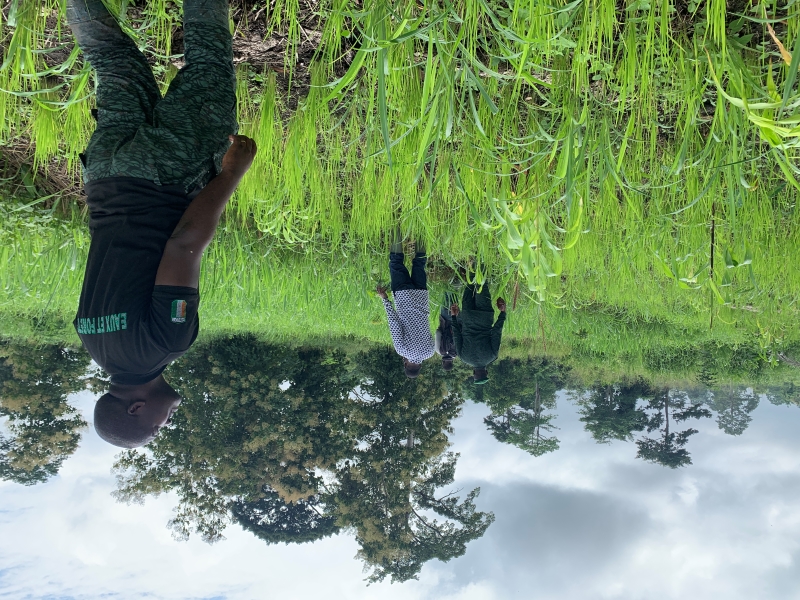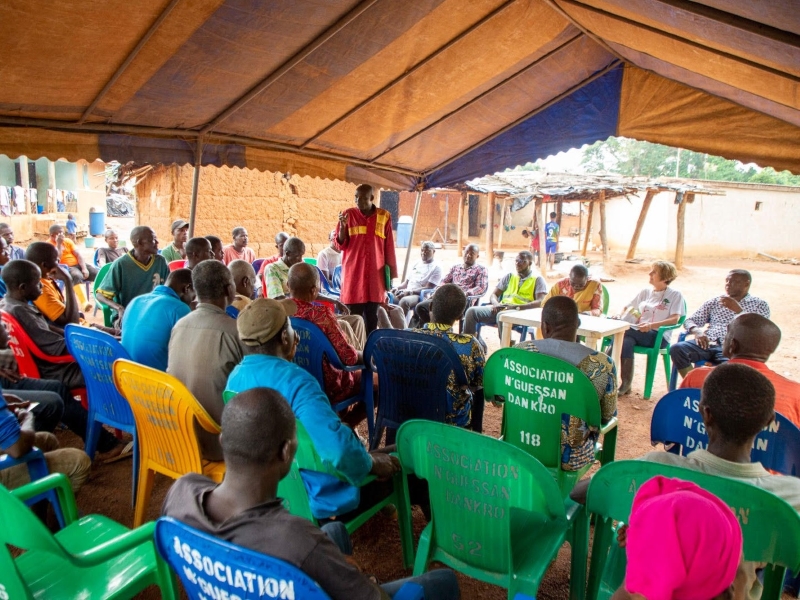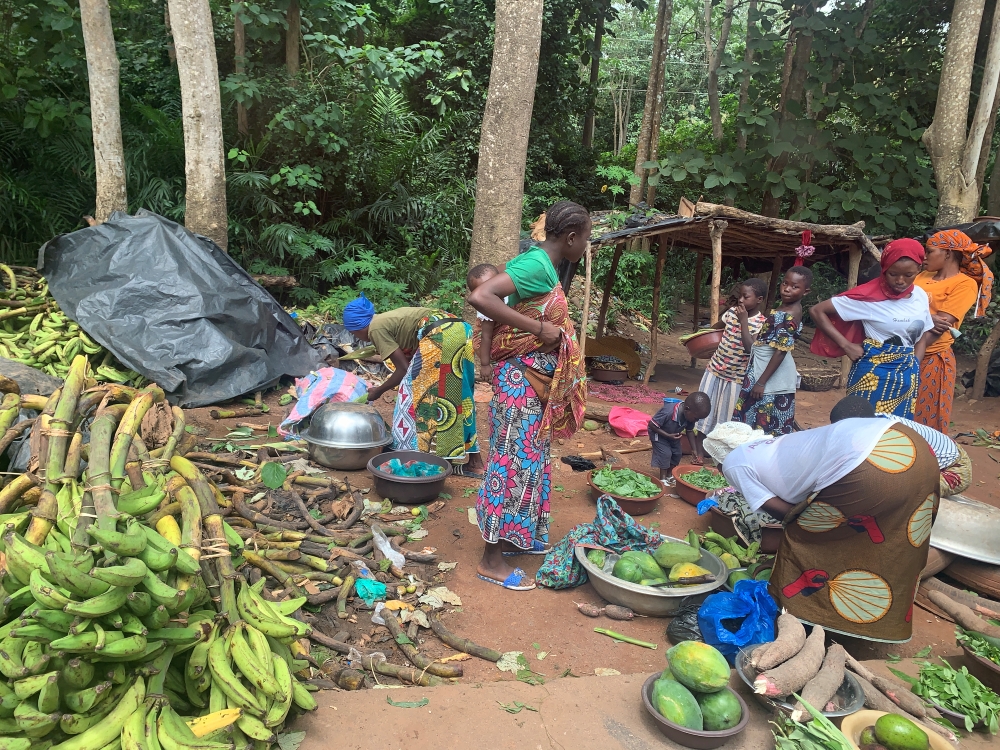Trees in cocoa-growing areas of Côte d’Ivoire

In the Botanic Forest of Divo, project team and MINEF rangers walk through a field that would have once held Raffia palms. Remnant trees are mostly native Terminalia species. Credit - Cathy Watson.
In cocoa-growing areas of Côte d’Ivoire where trees are needed, “there is no forest we can frisk and find this seed”
Our project, called ‘Growing threatened trees’ capacity to restore cocoa landscapes in Côte d’Ivoire,’ is located north of Abidjan, in and around the 6,800 hectare Botanic Forest of Divo. That may sound like a minuscule geography, but what we are working on is gargantuan in its implications.
Like its neighbour Ghana, Côte d’Ivoire now lives with an absence of almost all of its tropical, moist, broadleaf forest, having lost 96% of its Guinean Forest as it rose to supply 40% of the world’s cocoa (vs Ghana’s 20%).
Cocoa agroforestry involves introducing companion trees into cocoa farms to create a canopy for the health and productivity of the understory tree, Theobroma cacao, which is originally from Latin America, as well as for biodiversity and ecosystem services. Often this is done in the fastest way possible, using rapidly growing exotics and common local timber species; however, the benefits that might follow if cocoa agroforestry were also deploying rare native species cannot be ignored. Our Capability and Capacity project aims to do just that, broadening the palette of trees planted within cocoa orchards and across the wider ‘cocoa landscape’ to include species at risk of extinction.
"Cocoa agroforestry involves introducing companion trees into cocoa farms to create a canopy for the health and productivity of the understory tree."
Within just weeks of starting the project, an official from a cocoa company congratulated the project, saying, “Thank you for promoting species that are on the way to disappearing. Integrating them into cocoa agroforestry systems will protect them and conserve our local landscapes.”
The cocoa industry plays a central role in determining if a forest species disappears or holds on. Rare is the cocoa company that does not roll out agroforestry. In 2019, Côte d’Ivoire’s Conseil du Café-Cacao (CCC) pronounced that cocoa agroforestry was necessary to, “address the problems of climate change caused in part by the reduction of forest cover.” Raising awareness of the cocoa sector is one of our outputs, however, our immediate concern is the Botanic Forest of Divo, created in 1935. The desired outcome of our project is to improve the “capability, capacity, and commitment [increased] to restore the Botanic Forest of Divo with native trees, including threatened trees.”
Referred to by the team as “Le Darwin,” the project draws on previous work by project lead, CIFOR-ICRAF, to train nurseries to produce seedlings of trees that are compatible with cocoa and desired by farmers; by Botanic Gardens Conservation International (BGCI) to ‘rescue’ Aubregrinia taiensis, a ‘forest giant’ surviving only in isolated pockets in Côte d’Ivoire and Ghana; and by the Centre National de Floristique (CNF), which hosts and runs the national herbarium and a botanic garden.

The project was also inspired by the launch of the rehabilitation of the Botanic Forest of Divo in September 2022, at which the guest of honour, Minister of Water and Forests, Laurent Tchagba, said, “It is important that this forest remain among the botanic forests of Africa… We need an inventory so we know what is at risk.”
This became our playbook as we wrote the proposal. BGCI has responsibility for working closely with Côte d’Ivoire’s botanic gardens, and an inventory is already underway led by Dr Konan Yao, deputy director of CNF.
Yao’s early reports show that the Botanic Forest is more cultivated and less forested than originally thought, and we have scaled back our hope of finding the Critically Endangered Cola lorougnonis – though this was not a complete surprise. With the exception of parks, inhabited protected areas are the norm in Côte d’Ivoire. Communities live within them under the watchful eye of the Ministry of Water and Forests; the ultimate custodians. In July, the project team met with one such community resident in the Botanic Forest of Divo since the 1990s.

Clearly worried by the shrinking numbers of native trees for food, nutrition, and medicine, the community chief said, “Fruit and nut trees like bush mango (Irvingia gabonensis) and petit cola (Garcinia kola) are getting rare. Our edible caterpillars are vanishing for lack of trees. And we have to travel 200km to get plants to treat ourselves.”
“Without trees, there’s no rain,” said another elder, “and many of the sicknesses that afflict our cocoa come from the lack of forest.”
The community was also agitated about the large numbers of seedlings of teak (Tectona grandis) that they had previously been asked to plant. The Asian timber tree was greedy for space, they said, and its slow-to-degrade plate-sized leaves “dried the land.” Along with the cocoa companies and the Ministry of Water and Forests, which oversees all forest in Côte d’Ivoire, this settlement and others like it will be the project’s most important stakeholders.
From an initial list of trees in the Botanic Forest of Divo, we suspect we will find eight globally threatened trees: two Endangered (Pericopsis elata and Tieghemella heckelii) and six Vulnerable (Copaifera salikounda, Garcinia kola, Hugonia planchonii, Khaya ivorensis, Pseudospondias microcarpa, and Milicia regia).

Some of these, as well as other indigenous trees, are already part of cocoa agroforestry for some organisations. CIFOR-ICRAF, for instance, deploys eight varieties. However, much more can be done to popularise these and other native species as opposed to exotics like teak within the practice of cocoa agroforestry, which the government has converged upon to address the ‘ecological situation.’ Urgent attention also needs to be paid to seed sources and genetic diversity.
CIFOR-ICRAF has been building the capacity of nursery operators in Divo to raise seedlings for cocoa agroforestry since 2016, but the landscape has continued to lose mature trees. Describing the status quo, the proposal said: “Nursery operators source seed from just one or two remnant mother trees, driving these species toward inbreeding depression and loss of genetic diversity.” Travelling to Divo in July, CIFOR-ICRAF and CNF found the situation to be at least as concerning as described in the proposal, if not more.
Nursery operator, Ahoutou Kouadio Christian, reported sourcing from a single Kple tree (Irvingia wombulu), saying that Kple and Makore (Tieghemella heckelii) were disappearing. “We make appeals for petit cola (Garcinia kola) [but] it is very difficult to get. If people have the trees, they eat or use the seed. They don’t want to sell it.”
Nursery operator, Kouakou Yai Isidore, similarly said that obtaining seed was next to impossible for some species, describing ordering seeds from small stands of trees from as far as 150km away. Though he continues to believe in his nursery, from which he takes care of his family and has built a house, he said, “There is no forest we can frisk.”

But there is hope. The project will train trainers-of-trainers in seed collection across populations, rather than all from a single tree. Botanic gardens may also have genetically diverse living collections from which we can build back mother trees. CNF has seven Critically Endangered Cola lorougnonis, while the ORSTOM Botanic Garden holds endangered West African endemics Chrysophyllum azaguieanum and Placodiscus pseudostipularis. Others such as Le Jardin Botanique de Bingerville, which dates back to 1904, will have more.
Yet while cocoa agroforestry provides a possible solution, cocoa agroforestry is currently experiencing a downturn. Every nursery operator talked about raising seedlings they cannot sell. “You put your money in and get let down by buyers who promise but don’t come back,” said Christian, who employs five workers. “A lot of seedlings were distributed that were not put in the ground,” says the Divo region’s director for forests, Colonel Ansoh Banga, of the years 2019-2021 when agroforestry suddenly had the green light. “We need much more sensitisation.”
“Farmers still have resistance to trees in cocoa because they don’t understand the benefits and do not want to reduce the number of their cocoa trees,” says Commandant Sadrine Diarrassouba, Banga’s second in command.
"The value of cocoa agroforestry with threatened trees is undeniable."
This slump is a challenge for Le Darwin. One of the project’s outputs aims for: “20 local nurseries receiving a 50% increase in sales of threatened tree species.” We can achieve this by propagating threatened species like Cola lorougnonis, that are currently not raised at all, and by drumming up demand.
“This project is building capability and capacity to collect and propagate a wide array of indigenous threatened cocoa companion tree species,” says Dr Christophe Kouame, CIFOR-ICRAF Director for Côte d’Ivoire and Humid West Africa. “Our major outputs are conserving these in the Botanic Forest of Divo, supporting nurseries to raise and stock a wider range of trees, and growing the market for them by raising awareness of biodiversity among cocoa and other restoration actors.” Next year, the project will bring cocoa industry players to a national forum: the value of cocoa agroforestry with threatened trees is undeniable.
Written by Cathy Watson. For more information on this Darwin Initiative Capability and Capacity project DARCC037, led by the World Agroforestry Centre of CIFOR-ICRAF, please click here.

 Back
Back